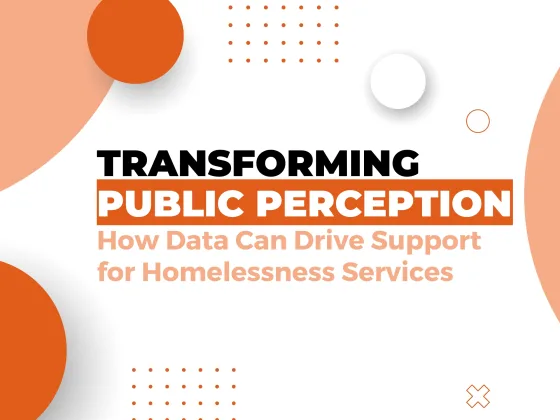Transforming Public Perception: How Data Can Drive Support for Homelessness Services
I had the privilege of attending the National Alliance to End Homelessness 2024 Innovations and Solutions for Ending Unsheltered Homelessness conference in March. As always when attending NAEH conferences, I felt a sense of hope for real change in improving homelessness support in communities across the US. One of the most exciting parts to me was seeing so many Continuums of Care (CoCs) and nonprofit organizations presenting on using their program data to help change the narrative about why people are affected by homelessness in this country. By changing the way the public perceives the homelessness problem in their communities, they have more support in making meaningful policy changes and the local and federal levels.
Addressing the Persistent Issue
Homelessness persists as a critical societal issue, affecting individuals and communities worldwide. On any given night in the US 653,104 people experienced homelessness in 2023. Since 2017 homelessness numbers have increased at least 6%. Despite its prevalence, misconceptions and stigma often cloud public perception, hindering efforts to address the root causes and provide adequate support. Data is helping to change these perceptions in communities across the country, but there is still so much work to do especially in states and cities where local laws are the harshest towards this population.
Challenging Misconceptions with Data
Public perception of homelessness is often influenced by stereotypes and misconceptions. There are several generalizations that are heard across the country — “mental illness and addiction cause homelessness,” “unhoused people don’t want help” and “people are coming here to be homeless.” Data serves as a powerful tool in challenging these preconceptions by providing a clear, evidence-based understanding of the issue. Through data analysis, policymakers and advocates can highlight the diverse demographics of the homeless population, dispel myths about the reasons for homelessness, and emphasize the structural factors, such as lack of affordable housing and economic inequality, that contribute to the problem.
In the book, Homelessness is a Housing Problem the data is clear that high cost of housing and few options for affordable housing is the main reason for the unacceptable numbers in this country. Furthermore, a recent report by the National Low Income Housing Coalition shows the devastating reality that no state has an adequate supply of affordable rental housing for the lowest-income renters. States with the highest supply are only around 50 affordable rental units per 100 low-income individuals while the lowest are around 24 per 100. By presenting this powerful data effectively, advocates can shift public perceptions and foster empathy and understanding toward those experiencing homelessness.
One presentation at the NAEH conference sticks with me in telling a story with data to shift public perception at the local level around homelessness and service providers. The CoC lead in San Diego, Regional Task Force on Homelessness shared their journey on how to shift the narrative around the state of homelessness in their county and the work they are doing to get folks housed. For a long time, the public did not trust that the work they were doing made any difference in addressing the homelessness problem. They found that the public could not easily access data about services and outcomes, while seeing more and more people living on the streets. They collaborated with service providers, policymakers, people with lived homelessness experience, and other community stakeholders to get on the same page with what is communicated simply and effectively. Part of this was using their HMIS data (nothing more) to have an Inflow/Outflow dashboard, built on Tableau, that is accessible to the entire community to get a current snapshot of the number of people housed and the number of new participants in housing services. Everyone in the community can use these numbers to support the need for more services and more affordable housing. They are simple data points, easy to understand and easily accessible. Since creating these easily accessible dashboards they have made strides in gaining community trust.
This highlights the critical role of technology in addressing homelessness, and it’s why we’re proud to offer the HMIS module as part of our comprehensive suite of solutions at Exponent Case Management. Our HMIS module provides organizations with a powerful tool to streamline housing programs, track outcomes, and ensure compliance with reporting standards. By harnessing the power of data, organizations can make more informed decisions, advocate for additional resources, and ultimately make a greater impact in their communities. Check out an on-demand demo of the HMIS Module here.
Building Empathy and Support
Data has the power to humanize the issue of homelessness by putting faces to statistics and highlighting the personal stories behind the numbers. Through storytelling and data visualization, advocates can convey the individual struggles and challenges faced by people experiencing homelessness, fostering empathy and generating support for homelessness services. At the NAEH conference, a large percentage of the attendees and presenters were those who have experienced homelessness and their stories are powerful. Leaders from Phoenix’s Fund for Empowerment shared how their lived experiences of street camping and rights violations from law enforcement have led to impactful advocacy in the Phoenix community.
Influencing Policy and Funding
Public perception plays a crucial role in shaping policy decisions and funding allocations. By leveraging data to change public attitudes toward homelessness, advocates can create a more favorable environment for policy change and increased investment in homelessness services. Through compelling narratives and evidence-based insights, they create a compelling case for proactive measures that address the root causes of homelessness and provide sustainable solutions.
Conclusion
Data has the power to challenge misconceptions, build empathy, and drive support for homelessness services. By harnessing the evidence-based insights provided by data, advocates can change public perception, influence policy decisions, and ultimately work towards ending homelessness and building more equitable communities.



